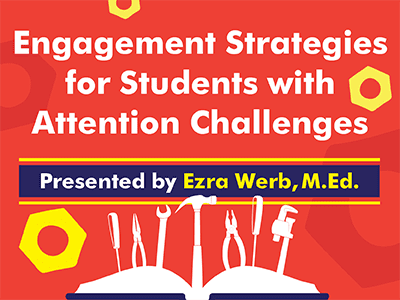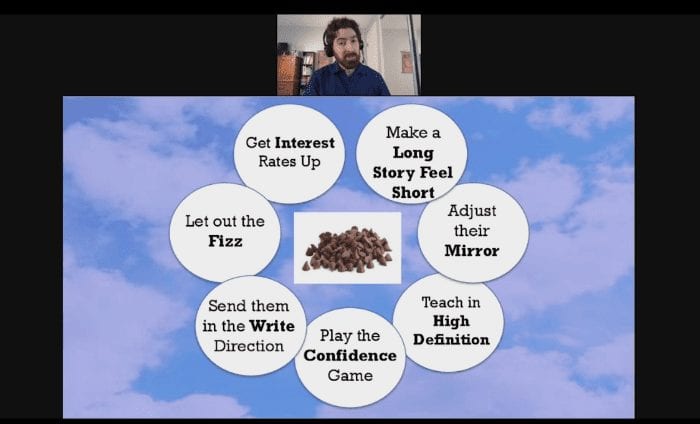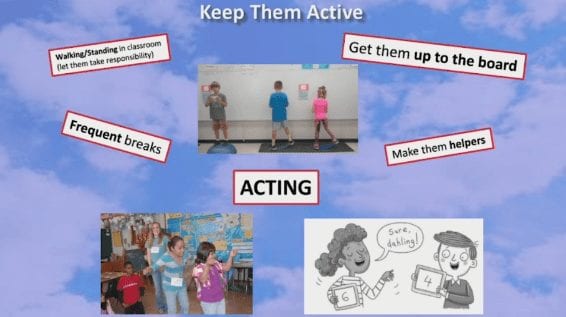Building Engagement in Students with Attention Issues
Engaging students with ADHD and attention challenges—rather than just managing their behavior—should be the goal for every teacher. Teachers worry, though, that they will have to create a separate curriculum or otherwise alter how they teach. Not so, said Ezra Werb, M.Ed., Educational Therapist and author, in his edWebinar “Engagement Strategies for Students with Attention Challenges: Lower Anxiety and Raise Confidence.” Instead, he offers strategies to lessen learners’ anxieties and raise their confidence so they can meet the same goals as their peers.
- Get interest rates up. Students’ interests aren’t talked about enough or used to a teacher’s advantage, said Werb. He suggested asking all students about their hobbies, likes, and activities. Then, the teacher can sprinkle these into the lessons, e.g., using favorite cartoon characters in word problems or having students write profiles of athletes, to grab attention. By meeting students in their areas of expertise, anxiety goes down and interest goes up.
- Let out the fizz. For students with sensory or hyperactivity disorders, the typical student desk can be detrimental. Maybe it’s too big for the kid and their feet dangle, or maybe the seat is too hard. While one solution won’t work for all, teachers can experiment with adjusting desks, providing footstools, or even letting kids sit on sweatshirts to allow them to focus on the lessons. In addition, providing opportunities for students to move around the room can help. And, of course, there are many fidget items—spinners, puddy, cubes—that can assist students. For those, the key is to make sure the fidget items don’t become a distraction.
- Make a long story feel short. Many students with attention issues also have a language processing disorder. It can be hard for a teacher to tell where one begins and the other ends. Werb found that frontloading required texts helps many students. For instance, he would explain the main characters, setting, key plot points, unfamiliar slang or anything that he thought would help them feel comfortable with the text. Other strategies include showing them the movie, letting them read the graphic novel version, or following along with the text while listening to the audiobook. While teachers want students to eventually be able to pick up a book and work on it without these crutches, these strategies help students get comfortable with longer texts.
- Send them in the write direction. First, Werb said giving some students a pencil to write with is like giving them a hammer to dig a hole. Even with a mechanical pencil, the instrument might be part of the problem. Whenever possible, he advocated for letting kids use technology. Being able to use a word processing program can provide immediate help for many students. For those with more complex issues, Werb found that letting them use slide presentation programs where the students can easily add graphics, organize their ideas shapes and colors, and move around their content can tap into their strengths as a learner. He also let students use speech-to-text programs.
- Teach in high definition. This means that every assignment, print or digital, should be as visually clear as possible. For example, he suggested that instead of cramming every math problem possible on a page, teachers space out the problems and make the page look less crowded. Also, let students use highlighters to mark different steps in the directions, or provide them assignments already color coded.
Even with these strategies, Werb cautioned teachers not to rush students to get on grade level. They can definitely reach the same achievement levels as their peers; the journey might just be longer.
“What we’re talking about here are incremental steps, incremental growth,” said Werb. “If you have a student…that struggles to even write a few sentences, expecting five paragraphs today is going to increase his or her anxiety…I think looking at these students’ incremental growth is super important in building confidence and not shutting down. So, we want to keep their goals the same, we want to keep the standards the same, but it just might take longer, and it might take more steps for them to reach it.”
This edWeb broadcast was sponsored by Free Spirit Publishing.
This article was modified and published by eSchool News.
About the Presenter
Ezra Werb, M.Ed. formerly a behavior interventionist and resource specialist teacher and currently an educational therapist, has been working with students with attention deficits, learning challenges, and spectrum disorders in typical classroom settings, resource rooms, and one-on-one academic support scenarios for more than a dozen years. Ezra earned his master’s in special education with a concentration in educational therapy from Cal-State Northridge and is a member of the Association of Educational Therapists. He lives in Boston, Massachusetts, where he works in private practice with students with ADHD, spectrum disorders, dyslexia, anxiety, and other learning challenges.
Join the Community
Social-Emotional Learning, Positive Behavior, and Student Achievement is a free professional learning community on edWeb.net that offers a place for educators to explore practical, effective ways to integrate social-emotional learning, inclusive teaching practice, and higher-level instruction.






Comments are closed.